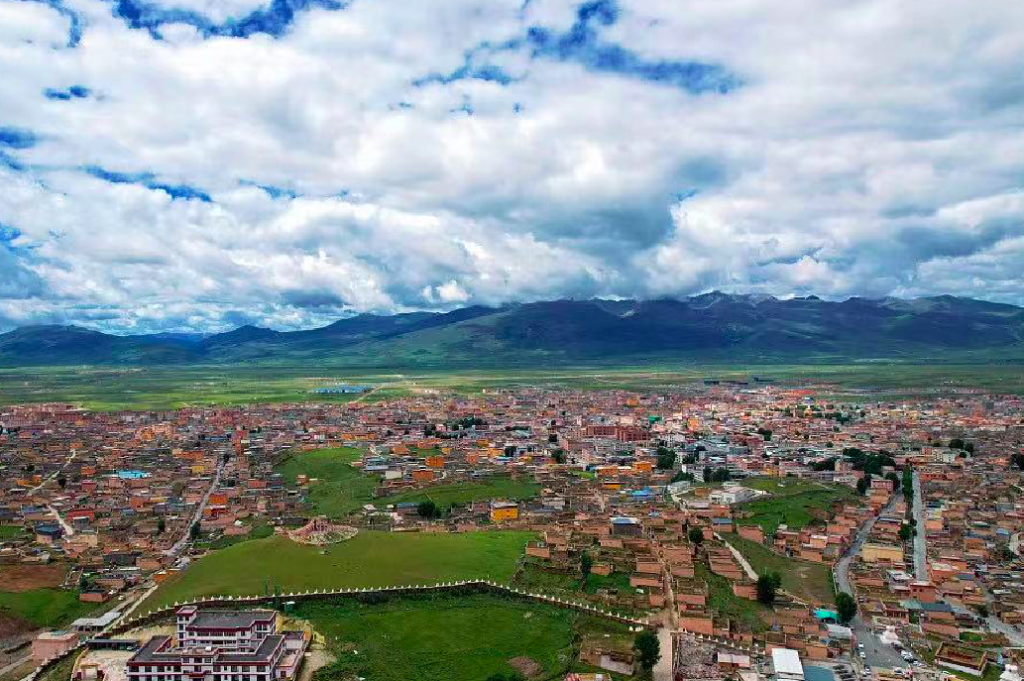
Litang County (理塘县), located in the Garzê Tibetan Autonomous Prefecture in Sichuan Province, China, is a remote and rugged area known for its stunning landscapes, rich Tibetan culture, and spiritual significance. It is often referred to as the “Highest County in the World” due to its elevation, which averages around 4,014 meters (13,169 feet) above sea level. Litang is a place where travelers can immerse themselves in Tibetan traditions while experiencing some of the most beautiful natural scenery in China.
Litang Grasslands
Litang is famous for its vast, high-altitude grasslands, which stretch as far as the eye can see. The lush meadows are dotted with nomadic Tibetan herders and their yaks, creating a picturesque scene.
Nomadic Culture: The grasslands are home to Tibetan herders who live in traditional tents and raise yaks and sheep. Visitors can witness their daily life, including herding, milking yaks, and making traditional dairy products.
Horseback Riding: The grasslands are ideal for horseback riding, which allows visitors to explore the vast open spaces like a traditional Tibetan nomad.
Wildlife and Birdwatching: The area is rich in wildlife, including Tibetan antelope, wild yaks, and various species of birds, making it a great destination for nature lovers.
Litang Monastery
The Litang Monastery (理塘寺), also known as Ganden Thubchen Choekhorling Monastery, is one of the most important Tibetan Buddhist monasteries in the region. It was founded in 1580 and is home to a large community of monks.
Tibetan Buddhist Architecture: The monastery complex features beautiful Tibetan Buddhist architecture with white and gold colors, impressive prayer halls, and intricate murals depicting Buddhist stories.
Monastic Culture: Litang Monastery is a place of great religious importance, and visitors can observe traditional Tibetan Buddhist ceremonies, rituals, and debates held by the monks.
The Tomb of the 7th Dalai Lama: The monastery is the birthplace of the 7th Dalai Lama, and his tomb is located within the complex, attracting pilgrims from all over Tibet.
The “Highest County in the World”
Litang is known as the highest county in the world, with an average elevation of over 4,000 meters. This makes it a place of great natural beauty, as well as a challenge for visitors due to the high altitude.
Stunning Views: The county’s lofty altitude offers sweeping views of the surrounding mountains and valleys, making it a photographer’s paradise.
Altitude Adjustment: Travelers should take time to acclimatize to the high elevation to avoid altitude sickness.
Mountain Scenery and Trekking
Litang is surrounded by snow-capped mountains and offers numerous trekking opportunities. The high-altitude landscape is diverse, with valleys, lakes, rivers, and glaciers.
Trekking Trails: There are several trekking routes in Litang, including hikes to nearby peaks and through valleys where trekkers can enjoy solitude and untouched nature.
Horse Racing Festival
The Litang Horse Racing Festival is an annual event that takes place in the summer, celebrating the region’s equestrian culture.
Traditional Races: The festival includes thrilling horse races where riders, many of them nomads, compete on horseback, showcasing their skills and the importance of horses in Tibetan culture.
Cultural Celebrations: The festival is a vibrant celebration of Tibetan culture, with music, dancing, and traditional rituals. Visitors can experience the local hospitality and join in the celebrations.
Tibetan Food and Culture
Litang offers a rich cultural experience, with a strong emphasis on Tibetan traditions and cuisine.
Tibetan Cuisine: Enjoy local dishes like tsampa (roasted barley flour), yak butter tea, and momo (dumplings). Litang is also famous for its yak meat and dairy products, which are a staple of the diet.
Traditional Handicrafts: Visitors can find Tibetan handicrafts such as woolen goods, colorful prayer flags, and handwoven carpets made by local artisans.
Tips for Visiting Litang County
- Best Time to Visit: The best time to visit Litang is during the warmer months (May to October), when the weather is milder. Winter can be harsh and cold due to the high altitude, making travel more difficult.
- Altitude Awareness: Litang’s high altitude requires travelers to take precautions against altitude sickness. It is essential to drink plenty of water, avoid exertion during the first few days, and acclimatize gradually.
- Getting There: Litang is accessible by road from Kangding or Shangri-La, but travel can be long due to the mountainous terrain. Travelers should prepare for a scenic but bumpy journey.
- Respect for Local Customs: Litang is a deeply religious region, and it’s important to respect local customs, especially at religious sites like monasteries. Always ask for permission before taking photos, particularly of monks and religious rituals.
- Packing Tips: Be sure to bring warm clothing, especially if traveling in the shoulder seasons or winter. Even in summer, temperatures can drop significantly at night due to the altitude.
- Accommodation: Accommodation options in Litang are basic, ranging from guesthouses to small hotels. It is advisable to book in advance during peak seasons, especially if visiting during the Horse Racing Festival.
Litang County is a hidden gem in the Tibetan plateau, offering breathtaking landscapes, a rich cultural heritage, and a chance to experience Tibetan life in a remote and unspoiled setting. Whether exploring the expansive grasslands, visiting the historic Litang Monastery, or attending the Horse Racing Festival, Litang promises a unique adventure for those seeking both cultural immersion and natural beauty. Its high-altitude environment, traditional Tibetan lifestyle, and serene landscapes make it an unforgettable destination for adventurous travelers.
 Tibet World Travel Tibet Tour, Tibet Trip, Tibet Travel, Tibet Train, Tibet Trekking,
Tibet World Travel Tibet Tour, Tibet Trip, Tibet Travel, Tibet Train, Tibet Trekking,
